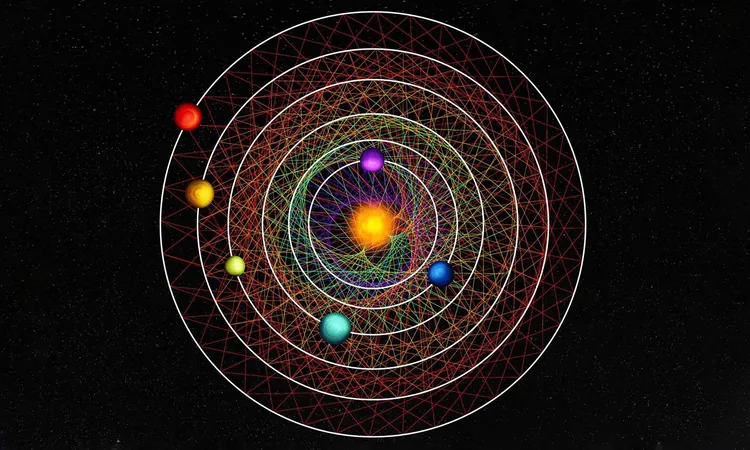
Six-Planet System Discovered: A Cosmic Symphony of Synchronized Orbits!
2025-01-12
Author: Wei
Six-Planet System Discovered: A Cosmic Symphony of Synchronized Orbits!
A groundbreaking discovery has unveiled a mesmerizing six-planet system that moves in perfect mathematical harmony. This astonishing configuration, named HD110067, is located approximately 100 light-years away in the northern constellation of Coma Berenices. The system features six sub-Neptune planets that orbit a single star in a stunning display of resonance—a phenomenon where planetary orbits maintain a fixed ratio for millions, if not billions, of years.
Resonance: The Cosmic Symphony
Resonance among celestial bodies is akin to a rhythmic music tempo, allowing astronomers to comprehend why certain stars host families of planets that exhibit stability over eons. The analysis of this unique system was led by Rafael Luque from the University of Chicago. Using data from NASA’s Transiting Exoplanet Survey Satellite (TESS) and the European Space Agency’s CHaracterizing ExOPlanet Satellite (Cheops), researchers detected unusual dips in the star's brightness, signifying planets crossing in front of HD110067.
“This discovery serves as a benchmark for exploring the formation, evolution, and potential habitability of sub-Neptune planets,” Luque emphasized, noting these planets are among the most common types in the universe.
Understanding the Sub-Neptune Enigma
Sub-Neptunes, planets larger than Earth yet smaller than Neptune, are abundant in our galaxy. These worlds exhibit a variety of compositions, from thick gas envelopes to solid, rocky surfaces. The synchronized motion of HD110067's planets provides critical insights into how these systems maintain their configurations against the backdrop of cosmic forces. Despite the complexities involved, particularly among multi-planet systems, this arrangement showcases a rarity, with only about one percent of such configurations persisting in stability.
The protective environment of HD110067 plays a significant role; absent larger planetary neighbors that could disrupt gravitational harmony, the six sub-Neptunes have likely retained their precise orbits since their formation.
The Significance of the Discovery
For astronomers studying planet formation, every new system that displays clear resonant patterns offers pivotal evidence regarding the processes by which dust and gas coalesce into planets. It is hypothesized that planets might begin in resonance, only to later lose this alignment through migration or collision. The pristine state of HD110067 presents a unique opportunity to examine early formation processes and accurately determine each planet's mass and density.
To further investigate, researchers plan to deploy advanced techniques for more accurate measurements. This deeper analysis could reveal whether these planets possess the conditions necessary for liquid water—a critical factor for potential habitability.
A Call to Astrophysical Curiosity
The existence of this synchronized planetary ensemble ignites curiosity among scientists and space enthusiasts alike, offering a rare view into the underlying patterns that govern our galaxy. This discovery could represent just one of many undisturbed systems, motivating astronomers to search for other resonant configurations lurking among the stars.
As researchers continue to study the HD110067 system, they strive to unlock the mysteries of planetary formation and the intricate dynamics that lead to stable orbits. The findings, published in the prestigious journal *Nature*, promise to expand our understanding and challenge prevailing theories of celestial mechanics.
Stay tuned for more updates on this exciting cosmic journey, and reveal the secrets of the universe!

 Brasil (PT)
Brasil (PT)
 Canada (EN)
Canada (EN)
 Chile (ES)
Chile (ES)
 Česko (CS)
Česko (CS)
 대한민국 (KO)
대한민국 (KO)
 España (ES)
España (ES)
 France (FR)
France (FR)
 Hong Kong (EN)
Hong Kong (EN)
 Italia (IT)
Italia (IT)
 日本 (JA)
日本 (JA)
 Magyarország (HU)
Magyarország (HU)
 Norge (NO)
Norge (NO)
 Polska (PL)
Polska (PL)
 Schweiz (DE)
Schweiz (DE)
 Singapore (EN)
Singapore (EN)
 Sverige (SV)
Sverige (SV)
 Suomi (FI)
Suomi (FI)
 Türkiye (TR)
Türkiye (TR)
 الإمارات العربية المتحدة (AR)
الإمارات العربية المتحدة (AR)